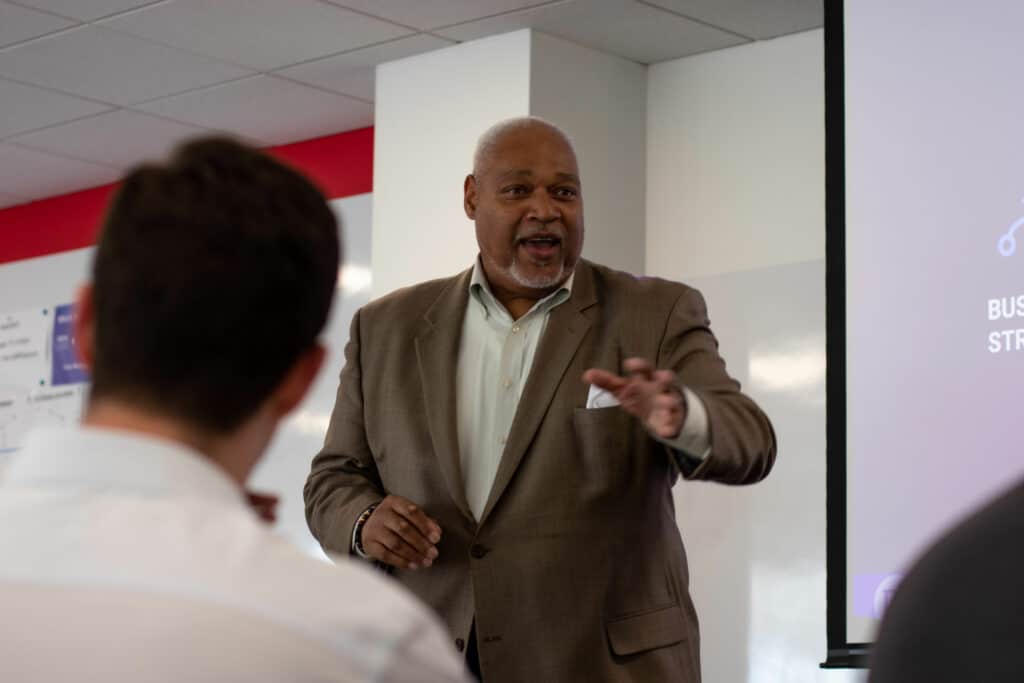Great leaders are more challenging to find than you might think, and who you choose to lead a team can have long-term effects—both positive and negative.
Not only does a leader need to steer a team toward success, but their performance and effectiveness tie directly to their employees’ level of engagement.
Successful organizations can attribute their accomplishments and growth to effective team leadership. Effective leaders know that the best way to achieve their goals is by building up the individuals around them.
However, what goes into a great leader? What kind of person is required to take a team from good to great?
Let’s dive into what to look for in a team leader and explore the impact a great leader can have on their team. We’ll cover:
- What are the characteristics of good team leadership?
- Why is leadership important in a team?
- How do you select a team leader?
- What are the skills of a team leader?
- What should new team leaders do first?
- What is an effective leader?
Related: How to Become a Better Leader

What are the characteristics of good team leadership?
Team members often expect their leader to wear various hats, and it’s critical that leaders can adapt their management style to certain situations. For example, a team leader may be responsible for:
- Providing guidance on business strategy and execution
- Tracking project progress and keeping members informed
- Facilitating open team communication to build relationships
- Motivating people to reach their individual and team milestones and goals
- Coaching team members to get back on track when plans go astray
- Supporting the company culture and raising team spirit when morale is low
Team leaders are expected to fulfill a wide variety of duties and responsibilities. Project manager, motivator, mentor, role model, liaison—it can be challenging to find someone who can juggle all of these roles effectively.
However, you’ll find that these leadership roles all require the same essential characteristics. The following traits can be found in many high-performance leaders:
1. Visionary
“Good leaders have a vision and inspire others to help them turn vision into reality. Great leaders have vision, share vision, and inspire others to create their own.” —Roy Bennett
Carrying out the company’s vision starts and ends with team leaders. Great leaders can help their team envision its common goals and clearly communicate the impact and importance of the team’s day-to-day work.
When a leader can align their team with the organization’s business strategy and vision, you will find that your employees are more engaged and will have an overall more positive experience at work.
2. Decisive
Time is of the essence when it comes to getting things done, and this includes time spent on making decisions.
A decisive leader can make informed choices that also take timelines into consideration. The leader’s decision-making process sets the tone and pace for the team, so a confident approach is vital to keeping productivity steady.
3. Influential
Leaders who can inspire and motivate their team members to take action without micromanaging or barking out directives will build a more collaborative work environment. A leadership title doesn’t necessarily equate to influence; respect is always earned, not guaranteed.
Influential leaders are able to connect emotionally with their team, be vulnerable, and build long-lasting relationships.
4. Humble
When it comes to leading a team, the less ego, the better. Leaders who can check their egos at the door will be able to more effectively listen, reflect, and learn from those around them.
However, this doesn’t mean they’re not confident. Confidence and humility are a wonderful combination. The result is a leader who can act decisively and with empowerment—without being blinded by their own pride.
Humility is often a rare trait in leaders. It requires acknowledgment that they don’t have all the answers, and the ability to admit when they’re wrong. According to the Harvard Business Review, self-aware leaders see and uplift the value in their team members because they see them as assets, not threats.
5. Risk-oriented
If you want to take your business to the next level, put your faith in leaders that are willing to take risks to achieve their goals. Courageous leaders will, in turn, inspire their team to think outside the box, take appropriate risks, and try new approaches.
That said, there are plenty of times where a risk-averse mentality is just as valuable. A particularly strong leader, then, understands when it’s OK to push the envelope, and when a decision requires more sensitivity.
6. Passionate
If you want a team to believe in what they’re doing, look to the leader. Effective leaders practice what they preach, and you would never catch a passionate leader saying, “It’s just a job.” They care about their work, their organization, and their team development.

Why is leadership important in a team?
Strong leadership determines how effective and successful a team will be in many ways, like keeping others accountable, executing strategic plans, and properly delegating duties.
However, good leadership is also crucial to the overall happiness of a successful team. It may seem obvious that having a good leader as a boss can make a difference at work, but to be frank, this can’t be stated clearly enough.
According to The Predictive Index’s People Management Survey, only 18% of people with great managers plan to leave their jobs within the next 12 months compared to 77% of people with bad bosses.
We found in the same study that 94% of survey respondents with great bosses have passion and energy for their jobs. On the other hand, only 59% of employees with bad bosses can say the same.
You’ve likely heard the saying, “People don’t leave jobs, they leave bad managers.” Well, the inverse is also true: People don’t necessarily stay for the job, but they will stay for a good leader.
Read More: Leadership Tools Every Manager Should Be Using
How do you select a team leader?
Selecting team leaders is one of the most critical decisions a company will make. Your organization’s leaders will have both a short- and long-term impact on the overall health and success of an organization.
Good team performance is a reflection of the quality of the leader. Take the following criteria into consideration when selecting a new team leader:
- The candidate empowers others, rather than flexing their own power. A leader who can serve as both a guide and a mentor will bring the team together.
- The candidate leads by example. Team members can more easily relate to someone who models their expectations and acts according to company goals.
- The candidate utilizes their communication skills to share their vision, expectations, and directions. This skill goes a long way in eliminating confusion and keeping the team on task according to deadlines.
- The candidate’s core competencies map to the business strategy at hand. Some skill sets are more suited for certain goals than others. An ideal leader will be one whose competences relate directly to the team’s goals.
Overall, when selecting an effective team leader, look for a well-rounded person who truly motivates and inspires others around them.

What are the skills of a team leader?
You’ll find that team leaders often naturally possess certain skills. The right leader for the job will consciously choose to hone these skills and use them in their everyday work.
The following team leader skills will inspire trust, collaboration, and respect in a team:
- Listens to others: A leader who is a strong verbal and written communicator listens respectfully to the input of others. They recognize and appreciate the importance of having diverse viewpoints on their team.
- Delegates effectively: When a leader can delegate important tasks to other team members, they’re fostering leadership and responsibility in their colleagues. Delegation signals trust in others and allows the leader to focus on higher-level responsibilities.
- Builds strong team relationships: A team builder is adept at developing new relationships, both with and among others, and strengthening existing ones.
- Facilitates powerfully: Leaders must be able to help their team understand their goals and strategic plans. Facilitation and communication skills ensure team members recognize the importance of their work objectives.
- Remains resilient in the face of adversity: Even the best laid business plans can fall apart. When faced with roadblocks, how a leader responds plays a significant role in how the team will respond.
What should new team leaders do first?
A leader’s first impression will set the tone for their relationship with their team.
If they try to rush into things too fast before they establish a solid foundation of trust, it could put off some members. Or, if they make the mistake of assuming team members will know how they operate or what they expect, they will find that team members are frustrated and confused.
Rather than rushing in or assuming people understand their desires, new leaders should implement a strategic onboarding plan to set themselves up for success.
New leaders could take the following steps to ensure a smooth and successful start to their new relationship with their team:
- Take the time to get to know each team member on an individual level.
- Recognize the accomplishments and successes of each team member.
- Conduct team-building exercises to create a collaborative environment.
- Let the team get to know them as an individual by sharing their values and priorities.
- Form group norms and expectations around processes, culture, and work styles.
- Establish clear goals and objectives.
The Predictive Index found that the number one skill managers lack is team building. Nearly 30% of employees surveyed stated that their managers lacked team-building skills, which had a negative impact on their experience at work.
New leaders would do well to put time and thought into their strategy for strengthening relationships and building camaraderie. It will go a long way in winning over their team members and helping them feel like a more cohesive unit.
Give your leaders the tools they need to lead effectively and get the work done. With PI Team Discovery, new leaders can hit the ground running. By assessing their strategic goals and mapping them to team members’ behavioral styles, members can thrive in the roles they’re well suited for while leaders focus on strategy.
What is an effective leader?
An effective leader is someone who has a purpose that goes beyond their own personal agenda.
With a personality that maps to the needs of the organization, an arsenal of developed leadership skills, and the drive to knock goals out of the park, an effective leader will drive growth and innovation.
There’s no set-in-stone formula for what makes a great leader (and in turn, a great team). However, with the right combination of skills and characteristics, a leader can effectively empower and enable a team while leading them to victory.
Join 10,000 companies solving the most complex people problems with PI.
Hire the right people, inspire their best work, design dream teams, and sustain engagement for the long haul.








